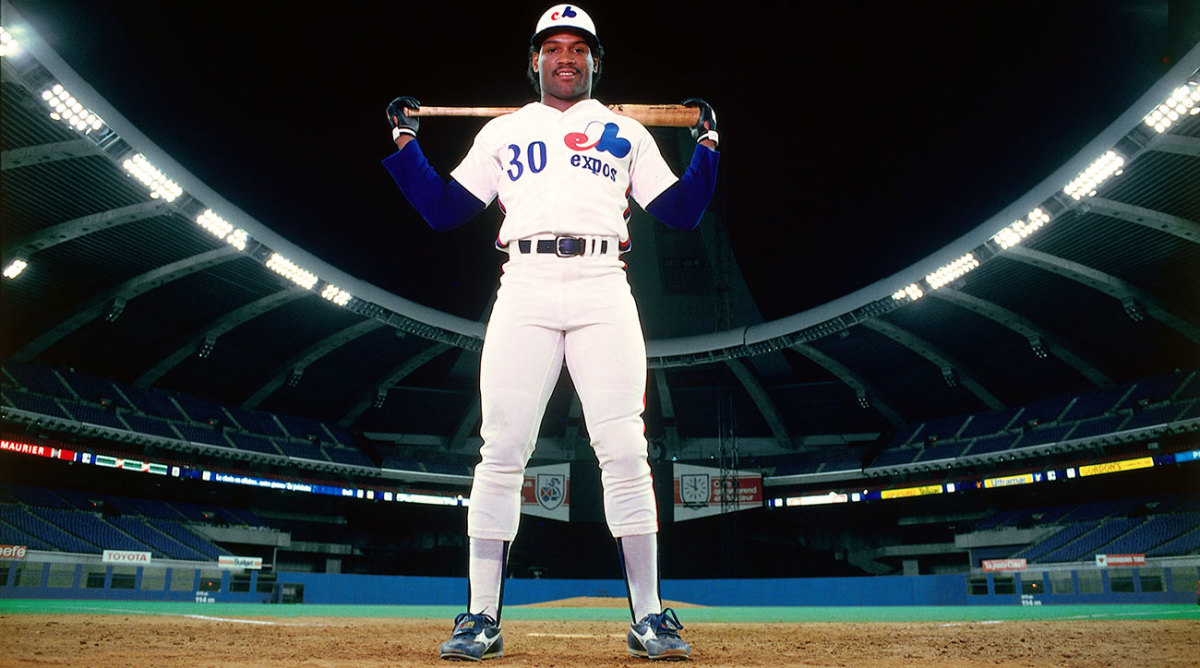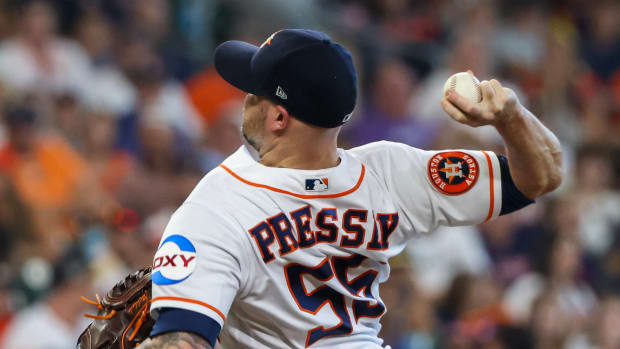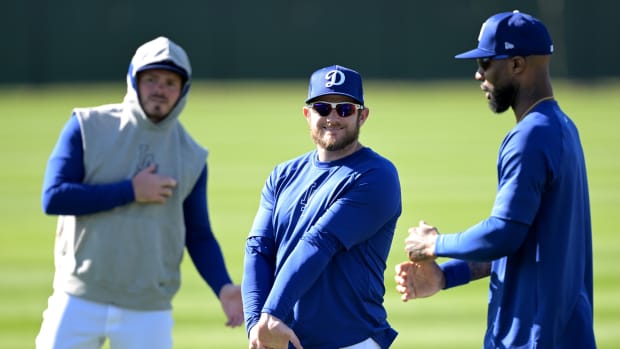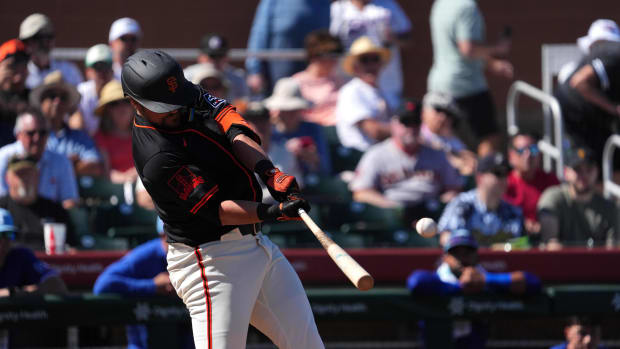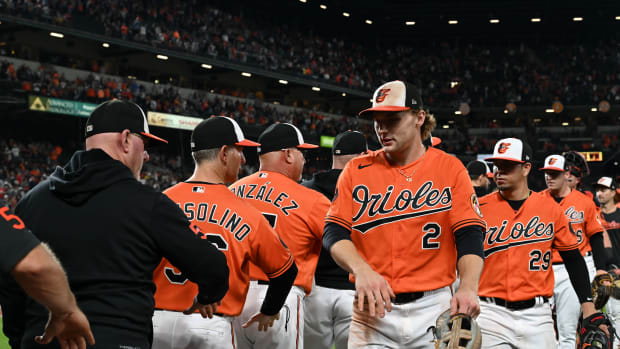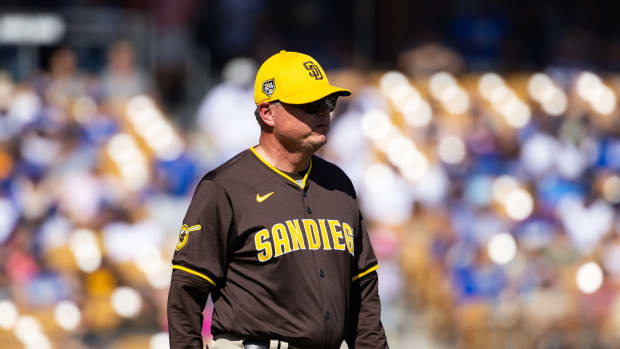JAWS and the 2017 Hall of Fame ballot: Tim Raines
The following article is part of my ongoing look at the candidates on the BBWAA 2017 Hall of Fame ballot. Originally written for the 2013 election, it has been updated to reflect recent voting results as well as additional research. For a detailed introduction to this year's ballot please see here. For an introduction to JAWS, see here.
Tim Raines spent much of his 23-year career playing second fiddle. Bursting upon the National League scene in 1981 after cups of coffee in the previous two seasons, he set a modern rookie record with 71 stolen bases but lost out in the Rookie of the Year voting to Fernando Valenzuela, whose Dodgers wound up upending Raines's Expos in their only postseason appearance. Raines had to yield to Andre Dawson, first as a teammate who occupied centerfield while Raines played left, then as a slugging rival who snatched away the NL MVP award in 1987, which was the speedy switch-hitter’s best season.
It was Raines’s fate to be cast as No. 2 among the rankings of leadoff hitters, tops next to everyone save for contemporary Rickey Henderson, who wound up setting the all-time records for stolen bases, walks, runs scored and third-person references. Raines didn’t play for a World Series winner until 1996, after injuries relegated him to a supporting role, and he could only watch while Tony Gwynn, a superstar of comparable value but far more glitzy accomplishments, waltzed into the Hall of Fame on the first ballot while he himself languished.
Where Gwynn collected 3,000 hits, won eight batting titles and spent his entire career with one team, Raines fell around four hundred hits shy of the milestone due to injuries and illnesses that took a chunk out of the second half of a career that grew increasingly nomadic as time went on. That isn’t to say that he didn’t accomplish a whole lot. For a considerable stretch in the 1980s, Raines had a claim as the NL’s top player. His seven All-Star appearances, four stolen base titles, two championship rings and a batting title are more than most players bring home, and to that, Raines added a claim as the greatest percentage base stealer of all time. Not only was he no slouch, but he also stands as one of the top 10 leftfielders of all time. He's a man worthy of a plaque in Cooperstown.
But just as Raines's candidacy was starting to build momentum, it was dealt a blow via the double-whammy of a flood of near-automatic first-ballot candidates and the Hall’s unilateral truncation of the eligibility window for all but three lost-cause candidates, from 15 years to 10. Faced with needing to gain 20% in his final two election cycles, he got a great jump on the 2016 ballot, climbing to 69.8%. He’s not quite an automatic for 2017, but no candidate has ever received such a high percentage and failed to gain entry at some point.
player | career | peak | jaws | h | hr | sb | avg/obp/slg | ops+ |
Tim Raines | 69.1 | 42.2 | 55.6 | 2,607 | 170 | 808 | .294/.385/.425 | 123 |
Avg. HOF LF | 65.1 | 41.5 | 53.3 |
|
|
|
|
|
Born and raised in Sanford, Fla., Raines starred in football and track as well as baseball at Seminole High School. The fifth of seven children, he was the second out of three who played professional baseball, preceded by Levi, who played in the Twins’ organization from 1975 to '77, and ahead of Ned, a second-round pick by the Giants in the January 1978 draft; neither climbed past Class A. A 5'8", 17-year-old switch-hitting shortstop when the Expos drafted him in the fifth round in 1977, Raines played primarily at second base in the minors, showing little power but outstanding plate discipline and great speed and earning September cameos as a pinch runner in 1979 and '80. After winning The Sporting News Minor League Player of the Year honors for hitting .354/.439/.501 with 77 steals in 90 attempts at Triple A Denver in 1980, he became the Expos' Opening Day leftfielder the following spring.
Dawson was the centerfield incumbent, the team's top star and a reigning Gold Glove winner, but the 21-year-old Raines quickly emerged as a star in his own right. In that strike-torn 1981, he hit .304/.391/.438, stealing a league-leading 71 bases (in 82 attempts) in just 88 games and racking up a respectable 3.5 WAR. That earned him All-Star honors and a second-place finish to Valenzuela in the Rookie of the Year voting.
If not for the strike and a broken bone in his hand suffered in mid-September, Raines likely would have become the fourth player since 1901 to steal at least 100 bases—Henderson had done it the year before—and might have toppled Lou Brock's single-season record of 118 before Henderson shattered it the next year with 130. As it was, the Expos made the playoffs for the only time in their history by winning the post-strike leg of the NL East race, and Raines returned in time for the NLCS against the Dodgers, who nonetheless prevailed in five games on the strength of Rick Monday's two-out, ninth-inning home run—a.k.a. Blue Monday.
JAWS and the 2017 Hall of Fame ballot: Jeff Bagwell
Though Raines again led the league in steals in 1982 with 78, his performance (.277/.353/.369, 2.8 WAR) was a mild disappointment, with a few games missed for unexplained reasons. In September, he admitted that he had “used drugs” earlier in the season but had stopped in May and was seeing a doctor at the insistence of the team; he also noted that his trying season had included his wife’s miscarriage and the death of a favorite uncle. After the season ended, he entered a rehab program and, upon completing a 30-day program, revealed that he had spent $40,000 on cocaine over the course of nine months and had occasionally played without any sleep (during the 1985 Pittsburgh drug trials, he said that he had taken up sliding headfirst to avoid breaking the vials in his back pocket). Raines had made an error of judgment, albeit in the context of being 22 years old and living in the majors' most notorious party city at a time when cocaine use was running rampant throughout the game. Thankfully, by all accounts, he successfully kicked his habit.
Free of that burden, Raines broke out the next year, the beginning of a five-year plateau (1983–87) in which he hit a cumulative .318/.406/.467 and averaged 114 runs scored, 11 homers, 71 steals, a 142 OPS+ and 6.4 WAR, never falling below 5.5 in that last category. He led the NL in steals in ’83 (a career-high 90) and ’84 (75) and ranked third or fourth among NL position players in WAR in four of those five years, finishing seventh in the other. For the period as a whole, only Wade Boggs, Henderson and Cal Ripken—all AL players and future Hall of Famers—were more valuable. The NL players immediately below him were Mike Schmidt, Gwynn, Dale Murphy, Ozzie Smith and Gary Carter—four future Hall of Famers plus a two-time MVP in Murphy.
Raines won the NL batting title in 1986, hitting .334 and leading the league with a .413 on-base percentage. Just 27 by the end of the season, he reached free agency that winter, but suspiciously, he received nothing but low-ball contract offers along the lines of a proposed one-year, $1.1 million deal from the Padres. Baseball was then in the midst of its collusion era, when commissioner Peter Ueberroth and team owners (including Bud Selig) conspired to hold down free-agent prices; in 1990, they would be forced to pay $280 million in damages to the MLB Players Association as a result. By the rules in place at the time, Raines was allowed to return to the Expos but ineligible to play until May.
As soon as he was permitted to negotiate, Raines signed a three-year, $5 million deal with the Expos. Without benefit of spring training or a minor league stint, he stepped into the lineup on May 2, turning a Saturday afternoon NBC Game of the Week against the Mets at Shea Stadium into the greatest comeback special since Elvis Presley's. He hit a first-inning triple off David Cone and a 10th-inning–game-winning grand slam off Jesse Orosco, good for a 5-3-4-4 boxscore line.
For all of the heroics, Raines conceded to Sports Illustrated’s Steve Wulf that he had some catching up to do. As Wulf wrote: "During the game, Raines needed tips on the Expos’ new hand greeting from Floyd Youmans and Herm Winningham. 'I had forgotten how to throw the high five,' said Raines. 'It had been so long. They’re now using forearms instead of hands.'"
For an encore, Raines led off with a homer the next day, a 2–0 win, and hit a go-ahead home run in the seventh inning against the Braves in his fourth game back. Later in the summer, he would put on a late-inning tour de force at the All-Star Game, entering in the bottom of the sixth and going 3 for 3 with a stolen base and a game-winning two-run triple in the 13th inning en route to MVP honors.
Raines set career bests for on-base and slugging percentages in 1987, hitting .330/.429/.526 with a career-high 18 homers as well as 50 steals; even after missing a month, he led the league in runs scored with 123. His 6.7 WAR ranked fourth in the league behind Gwynn (a career-high 8.5), Eric Davis (7.9, on a 37-homer, 50-steal season in just 129 games—a campaign that makes grown men weep when they're not holding it up as the closest analogue to Mike Trout’s 2012 that they've ever seen) and Murphy (7.7 in his final great season). For all of that excellence, the MVP award notoriously went to Dawson, whose 4.0 WAR ranked 18th; a victim of collusion himself, he hit 49 homers after signing with the Cubs, who took his blank check and paid him $500,000, less than half of what he had made in Montreal the year before. Raines finished seventh in the voting, part of a long-standing pattern of neglect by the BBWAA voters; though he received MVP votes in seven separate seasons, he never finished higher than fifth.
After that 1983–87 peak, injuries cut into Raines's playing time. He averaged just 133 games over the next six seasons and was traded in December 1990 to the White Sox in a five-player deal centered around Ivan Calderon. He spent five years on the South Side, the most valuable of which was his 1992 campaign (6.3 WAR). He actually hit better in 1993 (.306/.401/.480 with 16 homers) than in '92, helping the Sox win the AL West, but he missed six weeks due to torn ligaments in his thumb. Traded to the Yankees in December 1995, he was eased into a fourth outfielder/elder statesman role due to hamstring woes, though he earned two World Series rings in three years in pinstripes and hit a cumulative .299/.395/.429. He made further stops in Oakland, Montreal, Baltimore (where he briefly played with his son, Tim Raines Jr.) and Florida—losing one full year to a battle with lupus—before retiring at the end of the 2001 season.
Breaking down Today's Game Hall of Fame ballot, Part 3: The managers
Raines ranks eighth in career WAR among all leftfielders, exceeding the standard for Hall of Famers by 4.0 WAR. He's 10th in peak WAR, 0.7 above the standard, and eighth in JAWS, 2.3 points above the standard. Of the seven leftfielders above him, five are in the Hall of Fame—Ted Williams, Henderson, Carl Yastrzemski, Ed Delahanty and Al Simmons—with the other two being Barry Bonds and the banned Pete Rose (classified here because he had more value at that position than anywhere else). Fourteen other Hall of Fame leftfielders are below him in the rankings, including the BBWAA-elected Willie Stargell (15th), Ralph Kiner (19th), Jim Rice (28th) and Brock (36nd). If Raines's rankings sound crazy, consider that The New Bill James Historical Baseball Abstract placed him eighth among leftfielders back in 2001 as well.
Raines is often slighted because he doesn't measure up to Henderson, his direct contemporary and a 2009 Hall of Fame inductee who has been widely hailed as the best leadoff hitter of all time. Raines doesn't have 3,000 hits like Henderson; his 808 stolen bases rank "only" fifth all time; and while his 84.7% success rate is the best among thieves with more than 400 attempts (better than Henderson's 80.8%), that skill resonates less in today's power-saturated era, limiting the impression of his all-around ability. Being "the second-best leadoff hitter of all-time" isn't a tremendously catchy tag, either.
Via WAR and JAWS, Raines edges 2007 inductee Gwynn (68.1/41.1/54.9) across the board. Gwynn—who ranks 14th in JAWS among rightfielders, 3.2 points below the standard—gets the glory because of his 3,141 hits, five 200-hit seasons and eight batting titles. Raines won only one batting title and never reached 200 hits due to his ability to generate so many walks. Even so, he holds up quite well in a direct comparison.
player | avg/obp/slg | ops+ | iso | hr | sb | tob | tb | bg |
Gwynn | .338/.388/.459 | 132 | .121 | 135 | 319 | 3,955 | 4,259 | 5,267 |
Raines | .294/.385/.425 | 123 | .131 | 170 | 808 | 3,977 | 3,771 | 5,805 |
TOB is times on base (hits plus walks plus hits by pitch); BG is bases gained, the numerator of Tom Boswell's briefly chic mid-1980s Total Average stat (total bases plus walks plus hits by pitch plus stolen bases minus times caught stealing), presented here to show that Raines's edge on the base paths helped to make up for Gwynn's ability to crank out hits. The point is better served via the more comprehensive OPS+ and WAR valuations, but it’s nonetheless a worthwhile comparison for those wishing to stick to traditional counting stats. In terms of WAR components, Gwynn’s batting was 403 runs above average, but his baserunning was just 23 above average; Raines was 291 runs above average with the bat and 115 above average with the wheels. The rest of the component differences are negligible, with Raines in a slightly lower runs-to-wins environment, hence the slightly higher career WAR.
Traditional or advanced stats, the conclusion is the same: Gwynn and Raines were two fantastic ballplayers who had slightly different skills. One was disproportionately heralded in his time thanks to his extreme success by the traditional measures of batting average and hits, and the other was underappreciated in a career that included a more concentrated early peak and more ups and downs later. Raines was a hair more valuable on both career and peak measures, and there is no reason why he should languish outside the Hall while Gwynn is in. Perhaps because a certain segment of the voters continued to view his cocaine usage as unforgivable—forgetting that Paul Molitor battled his own problems with the drug, that Fergie Jenkins was arrested in Canada for possession of cocaine (and other drugs) and that Dennis Eckersley is said to have used as well—Raines has been slow to get his due from the voters.
Raines is now in his tenth and final go-round on the BBWAA ballot. He debuted at a dismal 24.6% on the 2008 ballot, then dipped slightly the following year before rallying, first to 37.5% in '11, then to 48.7% in '12 and 52.2% in '13. Crossing the 50% Rubicon was significant: Among players who have done so, only Gil Hodges and Jack Morris have failed to gain entry via either the BBWAA or various Veterans Committees, though Jeff Bagwell and Lee Smith remain in ballot limbo.
Alas, the 2014 first-ballot trio of Tom Glavine, Greg Maddux and Frank Thomas pushed Raines’s share back down to 46.1%. To add insult to injury, immediately after their induction, the Hall unilaterally declared that all candidates save for Smith, Don Mattingly and Alan Trammell would have their period of BBWAA ballot eligibility shortened from 15 years to 10. Instead of being at the midpoint of what was expected to be a slow, Bert Blyleven-esque climb to the 75% consensus, Raines had three cycles left. He rebounded to 55.0% in 2015, as holdover Craig Biggio and first-timers Randy Johnson, Pedro Martinez and John Smoltz were elected in the first four-man class since 1955.
Breaking down Today's Game Hall of Fame ballot, Part 2: Mark McGwire
Twenty percentage points appeared to be a tall order to make up over two ballots, but Raines’s jump to 69.8% on the 2016 ballot renewed hope that he would be recognized before his eligibility lapsed. Since the reinstatement of annual balloting in 1966, 21 players received between 69.0% and the necessary 75.0% for election (they don’t round up in this game). Sixteen were elected the next year, and a 17th (Red Ruffing) was actually elected in the same year (1967) via a since-discontinued runoff procedure. The remaining four were eventually elected, but not without drama. Two, Orlando Cepeda and Nellie Fox, landed in that close-but-no-cigar range in their final year of BBWAA eligibility and had to wait for the Veterans Committee several years later. Roy Campanella (69.9% in 1967) needed two additional election cycles—time that Raines doesn’t have—and Jim Bunning went from 70.0% in ’87 to 74.2% in ’88, then, maddeningly, back to 63.3% in ’89; he was eventually elected by the VC.
Looking at it another way, Raines may benefit from a slight final-ballot bump. Again going back to 1966, the 23 candidates in their last year of eligibility gained an average of 3.2%, which wouldn’t be enough for Raines, but if you limit the consideration to the 14 who received at least 35% in their penultimate year, they gained an average of 6.2%. That would be enough for Raines to join Ralph Kiner (1975) and Rice (2009) as the only post-1966 candidates to cross the 75% threshold in their final year.
If Raines doesn’t make it via the BBWAA ballot, it’s unclear whether he would pass directly into the post-Veterans Committee process via the newly-created Modern Baseball Era ballot (which covers players whose greatest impact came in the 1970–87 period) next year or the Today’s Game ballot (1988 onward) the year after. He played more in the later period (where the ballot is relatively lean among playing candidates, as this year’s slate attests), but his span as an elite player was in the earlier one, whose ballot may well contain the similarly worthy Trammell, Ted Simmons and Bobby Grich, as well as Morris and possibly Smith (should he fall short in his final year on the ballot). What’s more, the various small-committee processes haven’t inducted a living player since Bill Mazeroski in 2001. Hodges, who had some near-misses on the VC, received fewer than three votes in the 2014 Golden Era Committee balloting (balloting that’s based on a mathematically flawed premise, but that’s a horror story for another day).
Raines should never have had to wait this long, or at all. He deserves to go into the Hall of Fame before having to play second fiddle yet again. Here’s hoping the voters recognize the urgency of the situation and give him his due.






























